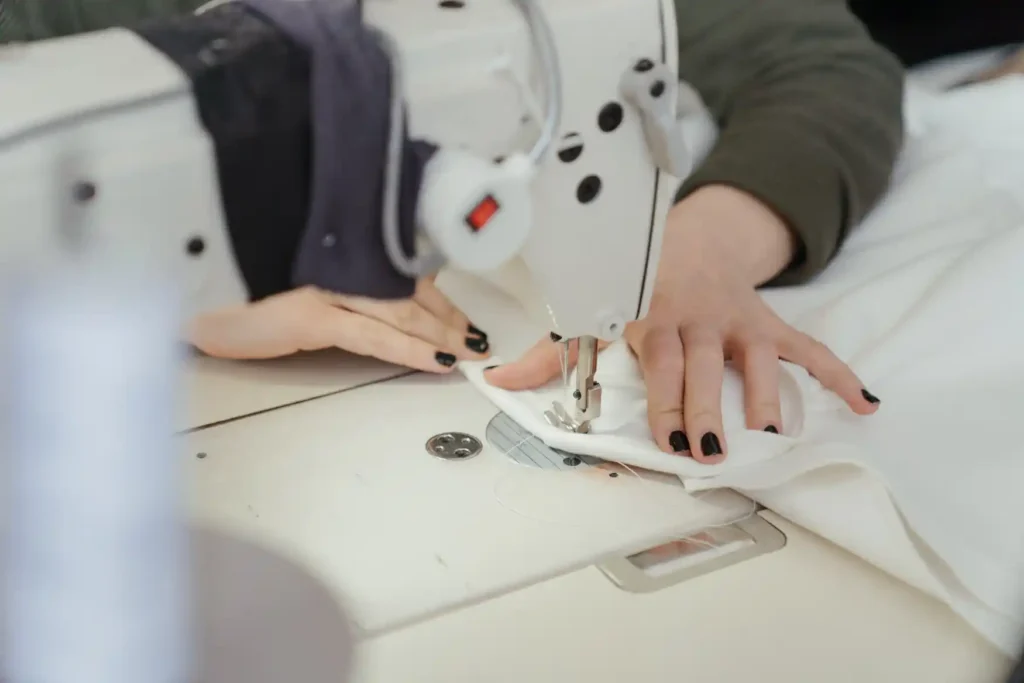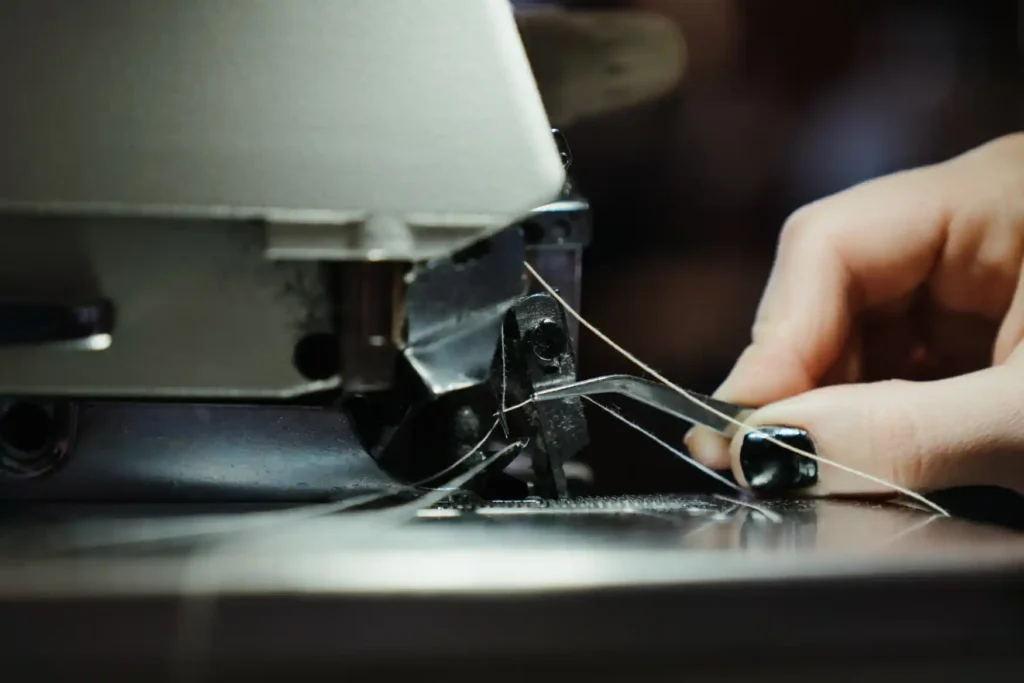Welcome to this complete guide on mastering the art of backstitching on your sewing machine!

Backstitching is an essential technique for achieving professional-looking seams that stand the test of time. By sewing backwards at the beginning and end of seams, you can secure stitches in place and prevent unraveling.
Read on to learn when and how to backstitch for flawless results.
Understanding Backstitching
Before we dive into the backstitching process, let’s build foundational knowledge. Backstitching is the act of reversing the sewing machine to sew backwards over existing stitches. This locks the threads in place, reinforcing the seam.
Backstitches are typically quite small – just 2 to 5 stitches in reverse at the start and end of seaming. But this simple technique makes a world of difference!
Backstitching serves the vital purpose of preventing seams from unraveling, keeping stitching intact. Have you ever noticed loose threads or frayed seams on store-bought garments? Chances are backstitching was overlooked.
Proper backstitching lends strength and durability to projects, increasing the lifespan of your precious handmade pieces. For the longevity of your sewing, backstitching is a must-have skill.
When to Use Backstitching
Experienced sewers backstitch as second nature, but beginners may wonder when it’s absolutely necessary.
The answer: any time you sew a continuous line of stitching, like a seam, you’ll want to backstitch the beginning and end. This includes seams for garments, home décor projects like curtains or quilts, bags, crafts, and more.
The most critical spots for backstitching are right as you start stitching and as soon as you reach the end. Keeping the first and last few stitches secure prevents the entire seam from unraveling. Backstitching mid-seam is also an option if you notice potential weak points along the line that could benefit from more reinforcement.
While backstitching adds a minute or two to your sewing time, it’s valuable insurance for the finished product. Forming a habit of backstitching at the beginning and end of every seam will take your sewing skills to the next level.
How to Backstitch on a Sewing Machine
Now that you know when to backstitch, let’s get into the how. The process consists of just a few simple steps:
Step 1: Prepare Your Sewing Machine
- Select an appropriate needle for your fabric type and weight. A Microtex/Sharp needle works well for most wovens.
- Insert a new needle if there are any signs of wear or defects.
- Wind a bobbin and thread your machine, following the manual instructions.
- Adjust the stitch length to a regular straight stitch (2.5-3mm).
Step 2: Position the Fabric
- Place your fabric layers under the presser foot with the area to be seamed aligned.
- Lower the presser foot lever.
Step 3: Sew Forward
- Start sewing slowly over the fabric, sewing straight stitches forward.
- Sew approximately 2-5 stitches forward from the starting point of the seam.
Step 4: Engage Reverse
- Stop sewing and engage the reverse function on your machine. This could be a reverse stitch lever, reverse button, etc.
- Consult your sewing machine manual for how to activate reverse.
Step 5: Backstitch
- With reverse engaged, continue sewing so the machine backstitches over the previous stitches.
- Sew 2-5 stitches in reverse to overlap the forward stitches.

Step 6: Disengage and Sew Forward
- Release the reverse mechanism to disengage it once you’ve sewn the desired number of backstitches.
- Resume sewing forward along the length of the seam as normal.
Step 7: Backstitch at End of Seam
- When you’re nearing the end of the seam, stop sewing when 2-5 stitches remain.
- Engage reverse again and backstitch to the end of the seam.
Step 8: Disengage and Tie Off
- Disengage reverse when you reach the seam’s end.
- Tie off threads or knot them by hand for added security.
And that’s it – follow those steps each time you sew a seam and your stitches will be locked in place! With practice, backstitching at the beginning and end of seams will become second nature.
Backstitching Versus Lock Stitch
While a backstitch is the most common way to secure a seam, there is another option: the lock stitch. This involves sewing a number of very tight stitches concentrated in one spot.
So what’s the difference, and when should you choose one over the other?
A true lock stitch is created by adjusting the stitch length to nearly 0mm, so stitches overlap very closely. This capability is built into many computerized sewing machines. If your machine lacks this function, you can mimic a lock stitch by stitching the same spot repeatedly at a short length.
Lock stitches are advantageous when sewing with fine, delicate fabrics like silk chiffon or lace. On sheer fabrics, backstitching can sometimes show through or disrupt drape. A lock stitch provides a more discreet alternative. Lock stitches also create less bulk in seams, an asset for garments with lots of slim seam allowances.
However, backstitching is definitely the strongest option and ideal for most fabrics like cotton, linen, and lightweight wovens. For sturdy seams that can withstand frequent washing and wearing, always opt for backstitching. Reserve lock stitches only for the most delicate projects.
No matter which technique you choose, securing stitching at the beginning and end of seams is a must. Take fabric characteristics into account when deciding whether a backstitch or lock stitch will produce optimal results.
Achieving Consistent Stitching
Creating consistent, even stitches is the hallmark of expert sewing. Proper backstitching relies on maintaining the same stitch length, keeping seam allowances straight, and stitching in perfectly straight lines. Here are some tips for achieving consistency both in your forward stitching and backstitches:
Utilize seam guides – Most sewing machines have built-in seam guides or you can add a universal guide. Align the raw edges of your fabric layers against the guide as you sew for a consistent seam allowance width.
Maintain even fabric contact – Gently guide the fabric with your hands as you sew to ensure the layers remain flat against the throat plate without bunching. Even pressure prevents varied stitch lengths.
Stitch slowly – Sewing too quickly can cause stitch inconsistencies. Maintain a moderate even speed for smooth stitching. Slow down even more for tricky areas like corners.
Check tension settings – Incorrect tension will impact stitch formation. Consult your manual for how to set both bobbin and upper thread tension properly.
Use quality thread – Poor thread breaks easily, leaving uneven stitches. Invest in good 100% polyester or cotton thread from reputable brands like Gutermann or Coats & Clark.
Insert a new needle – As needles wear down, stitch quality declines. Change needles frequently for best results.
With practice and these tips, your stitching lines will be flawlessly straight and uniform. Consistency is vital for stitch durability and professional finishes.
Preventing Seams from Unraveling
Now that you understand proper backstitching technique, let’s revisit why it’s so crucial: preventing those pesky seams from unraveling! Nothing ruins a handmade garment faster than stitches that come undone, leaving unsightly holes or frayed edges.
What causes seams to unravel?
This usually occurs when beginning or ending stitches come loose. Without backstitches to anchor the threads, they simply pull out stitch by stitch until a hole forms. Excess strain and tension on seams can also cause them to give way over time if not adequately secured.
By backstitching the first and last few stitches of every seam during construction, you can combat unraveling and keep seams intact. Those overlapping stitches provide reinforcement so the seam can withstand reasonable wear and tear.
Here are some additional tips to further prevent unraveling:
- Finish seam allowances with zigzag or overlock stitching to encase raw edges.
- Consider flat felled seam enclosures for ultimate strength.
- Avoid loose threads – clip and remove promptly.
- Inspect finished garments closely and hand-stitch any loose ends.
- Select quality fabrics that are less prone to fraying like natural fiber wovens.
Take preventative steps and your seams will go the distance!
Maintaining Fabric Drape and Hang
One last consideration when backstitching is the drape and hang of your fabric. As discussed, delicate and flowing fabrics like chiffon or crepe can be impacted by dense backstitching in the seams. The added bulk interrupts the graceful drape.
How do you maintain that beautiful drape while still securing stitches? Here are some tips:
- Opt for narrow 3mm seam allowances to reduce bulk.
- Grade or trim allowance widths – e.g. trim to 3mm after sewing 5mm.
- Lightly steam and press seams open after sewing to flatten.
- Use a lock stitch if available on your machine instead of backstitching.
- Set stitch length slightly longer (3-3.5mm) for gentler backstitching.
- Consider hand-sewing for the least interference.
The good news is that with thoughtful fabric selection and construction, you can find the right balance. Delicate silks and satins need extra special handling for that effortless drape, but the end result is so worth it.
Conclusion
We hope this in-depth guide provided everything you need to know about how to backstitch on a sewing machine. Simply remember to reinforce stitches by reversing 2-5 stitches at the start and end of every seam.
Backstitching truly takes your sewing to the next level for durable, quality results.
Soon this clever technique will become second nature. As you embark on your next project, don’t be intimidated by backstitching. With a little practice, you’ll achieve perfect locked stitches in no time. Your garments and other creations will benefit from seams that stay securely in place for their entire lifespan.
So turn that handwheel, engage the reverse button, and start backstitching your way to sensational sewing!
